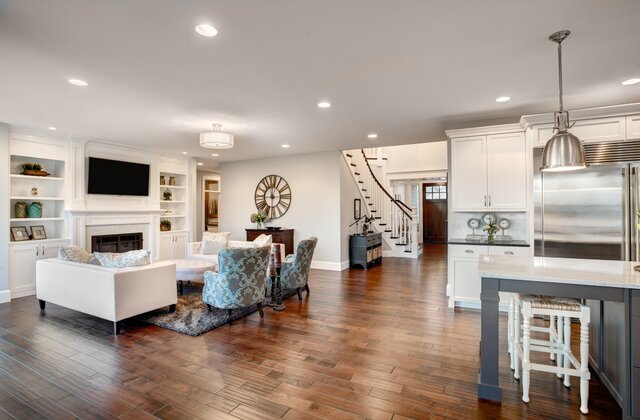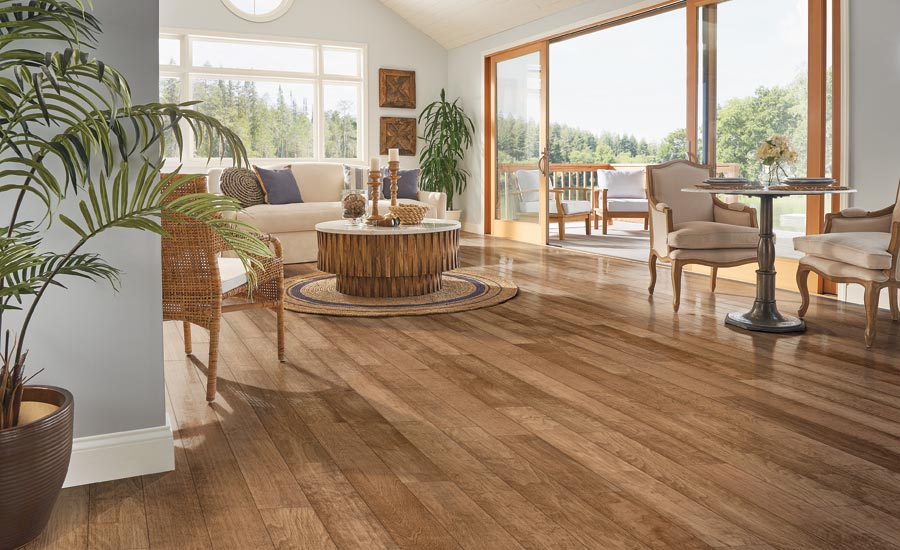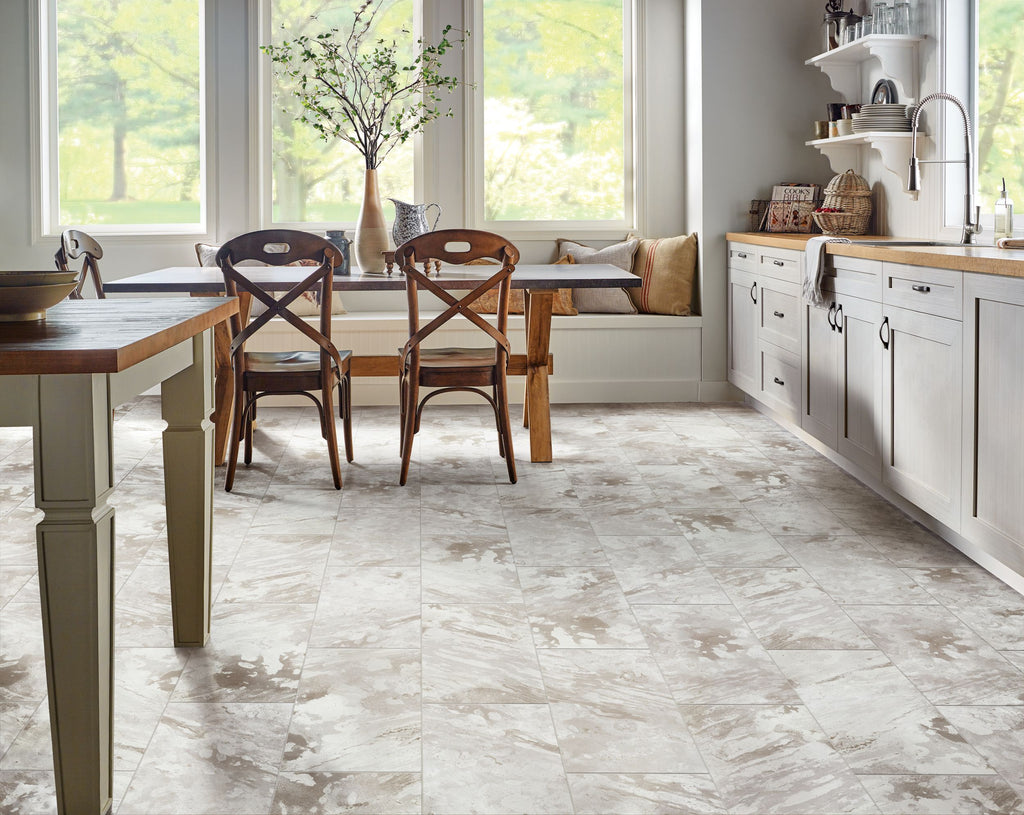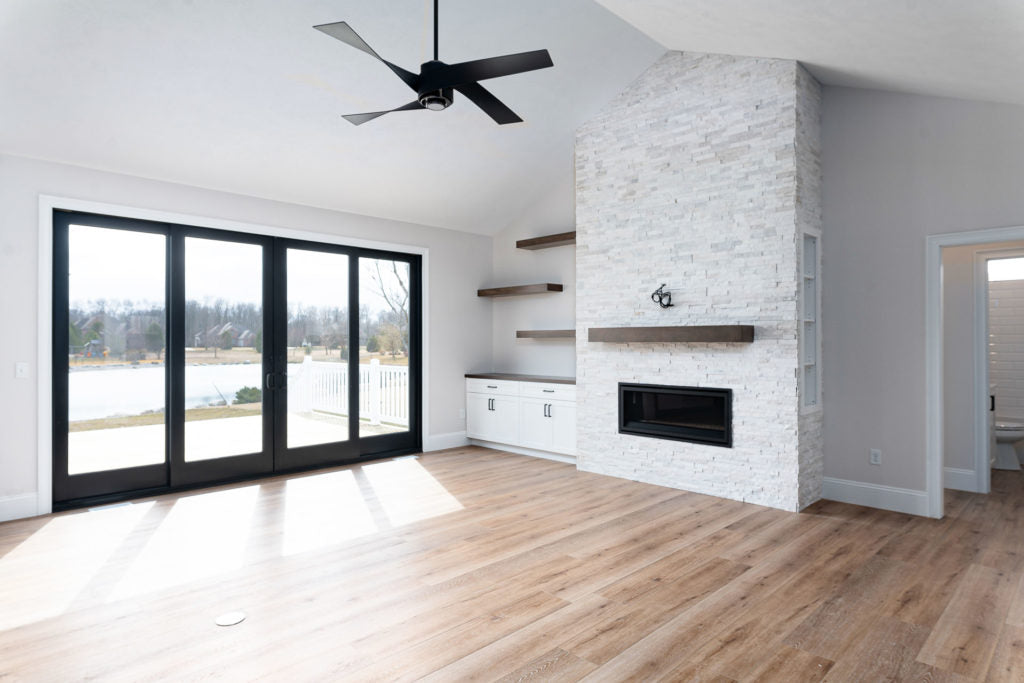Types Of Flooring For A New Home
The type of flooring for a new home is one of the most significant decisions an owner will have to make. A homeowner must select a flooring material that is properly matched to the intended use and foot traffic of each area in their home in addition to being an important visual design element. Listed below are the most popular flooring for a new home currently available to help you narrow down your choices.
1. Flooring For A New Home: Hardwood Flooring

There is a reason why historical homes often feature hardwood floors. As a timeless classic, hardwood flooring has the ability to provide both style and durability for your home, while at the same time helping keep its resale value in line with the market. There are a wide variety of woods, patterns, and stains to choose from, making hardwood flooring less visually limiting than many people would imagine.
With hardwood flooring, you can create anything from a bright contemporary look up to a rustic antique theme by simply selecting the right wood and patterns. Generally, hardwood flooring, particularly harder varieties, is the best choice for areas with high traffic and a requirement for durability, particularly if you have children or pets. If you are looking for a particular colour or tint, you can select an unfinished wood that can be custom stained. Furthermore, hardwood floors can be laid out in various patterns, including thin strips, wider planks, and even formal parquet patterns. Some of the most popular hardwoods available today are oak, maple, and cherry, which are valued for their looks, grain patterns, and durability. The use of exotic woods, such as teak, mahogany, and Brazilian cherry, may be an option if you have a limited budget.
2. Flooring For A New Home: Engineered Hardwood Flooring

Engineered hardwood is another flooring option for a new home, a hardwood flooring variant that is gaining popularity and that is created by cross-plying several layers of hardwood. Compared to pure hardwood, it is more resistant to humidity and temperature changes, making it an ideal material for damp areas such as bathrooms, laundry rooms, and basements. If damage occurs to engineered wood, it is more difficult to repair than traditional hardwoods.
3. Flooring For A New Home: Laminate Flooring

A laminate flooring product is composed of four layers of melamine-based materials (from the plastics family) bonded together. One of these four layers is an image of the surface which the laminate is intended to mimic at a high resolution. Thus, laminate offers a variety of visual options, including hardwood, tile, and stone. The laminate flooring material is extremely durable and suitable for use in most areas of the home depending on the type that is selected.
With laminate flooring, you can create or match almost any design theme you desire, since it mimics a large variety of materials, textures, and surfaces. Furthermore, it is one of the most cost-effective flooring options on the market. Most laminate flooring is not easily stained and clean up quickly with periodic sweeping, vacuuming, or damp mopping.
4. Flooring For A New Home: Vinyl Flooring

Vinyl Flooring is one of the most popular flooring options for a new home on the market today due to its affordability, durability, and ease of maintenance, especially in high-traffic rooms and areas with a bit of moisture. Unlike in years past, vinyl is now capable of visually mimicking a wide variety of surfaces, making it a popular choice among designers on a budget.
Vinyl flooring comes in a variety of styles, including sheets, tiles, and planks, giving homeowners more visual options than ever before while also requiring less installation time than other flooring materials. For even more design options, various shades of matte and gloss finishes are available. The use of vinyl flooring can contribute to the acoustical softening of a room in comparison with hardwood, laminate, or tile flooring. As a result, it provides a smooth surface for walking on, making it suitable for rooms such as kitchens where individuals may need to stand for long periods of time. Furthermore, the soft cushioning surface may slightly prevent dropped dishes and glasses from breaking. When properly prepared, vinyl can be installed over almost any flat, dry surface, which makes it one of the most versatile flooring options available. It is easily cleaned and does not require waxing as it did when it was first introduced.
5. Flooring For A New Home: Tile Flooring

Tile flooring is no longer restricted to just kitchens, bathrooms, and patios, but has rapidly become a popular flooring choice throughout the entire home due to its durability, elegance, and ability to be cut and shaped into custom patterns. A tile floor is ideal for environments with high moisture levels and heavy traffic.
Tile flooring is available primarily in ceramics, porcelains, and natural stones, offering a greater variety of design options. Various layouts of flooring tiles may be custom cut and installed and are available with a range of finishes, such as smooth or highly textured rustic surfaces, as well as variations in between. Additionally, grout can be painted in a variety of colours and shades to provide a visual element. The durability and water resistance of tile makes it an ideal flooring choice for areas with high traffic as well as for kitchens and bathrooms.
6. Flooring For New A Home: Carpet Flooring

Considering the variety of styles, colours, and patterns available, it is no surprise that carpet remains a popular flooring for a new home. Carpet fibers resist thermal transfer, thus making them one of the most comfortable flooring surfaces to walk on and stand on. They are also very effective at insulating a room, as they are able to retain heat. A carpet can absorb sound and quiet a loud room.
A carpet can be made from either natural fibers or manufactured fibers. Natural fibers are most commonly wool, which has a luxurious appearance while providing natural hypoallergenic properties that help to repel allergens. Wall-to-wall carpets are typically made from manufactured fibers to enhance durability. In today's market, nylon, polyester, and polypropylene/olefin are the most commonly used manufactured fibers. Nylon fiber is highly durable, stain-resistant, and easy to maintain. Since polyester is hypoallergenic, it is an excellent choice for homeowners concerned about catching allergens.
The top surface of a carpet is called the pile, which consists of loops that can either be cut or left uncut. There are many different types of piles available today, so homeowners should have little difficulty selecting the correct thickness and visual style for their homes. Carpet has the ability to absorb and dampen sound waves, making it an ideal choice for rooms with echoes or amplified noises as a result of cathedral ceilings or concrete countertops. The carpet fibers in high-traffic areas should be pre-treated with stain-resistant chemicals, which will make the carpet easier to clean and maintain. Carpeting is relatively easy to remove and replace when compared to other more permanent flooring surfaces.
Tips For The Flooring Of Your New Home

It is possible to request samples of most flooring options in order to avoid the trap of a given material appearing differently in the showroom than it appears in your home. It is important to view the samples in a variety of lighting conditions, especially if the room is subjected to varying shades of sunlight. A homeowner who is concerned about resale value should not cut corners when it comes to flooring, since it usually dominates the focal points of each room and is quickly noticed and judged by potential buyers.
Final Thoughts On Top Flooring For New Homes
Choosing the right flooring for a new home depends on the intended use of a given living area and your desired visual design theme. It is important to avoid selecting flooring materials based solely on their visual appearance and don't be afraid to mix and match according to the room, as it is uncommon that one flooring material is appropriate for the entire house. Large area rugs or carpets over wood floors are a classic design theme and an effective way to warm up a room and deaden sound when necessary. Choose flooring options that will not require constant maintenance or replacement on a regular basis for areas that will see high levels of traffic. While for high-moisture areas such as kitchens and bathrooms, choose flooring materials that are water-resistant.
Flooring blog articles you may want to read:
WHAT ARE THE ADVANTAGES OF LAMINATE FLOORING
WORD OF MOUTH FLOORS: LEADING PROVIDERS OF VINYL FLOORING IN VANCOUVER
